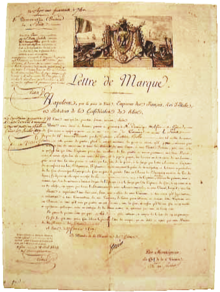
Back Kapersbrief Afrikaans تفويض رد اعتداء Arabic Patente de corsu AST Patent de cors Catalan Kaperei German Kaperisto Esperanto Patente de corso Spanish Lettre de marque French Patente de corso Galician Lettera di corsa Italian


A letter of marque and reprisal (French: lettre de marque; lettre de course) was a government license in the Age of Sail that authorized a private person, known as a privateer or corsair, to attack and capture vessels of a nation at war with the issuer, licensing international military operations against a specified enemy as reprisal for a previous attack or injury. Captured naval prizes were judged before the government's admiralty court for condemnation and transfer of ownership to the privateer.
A common practice among Europeans from the late Middle Ages to the 19th century, cruising for enemy prizes with a letter of marque was considered an honorable calling that combined patriotism and profit. Such legally authorized privateering contrasted with unlicensed captures of random ships, known as piracy, which was universally condemned.[1] In practice, the differences between privateers and pirates were slight, or merely a matter of interpretation.[2][3]
The terms "letter of marque" and "privateer" were sometimes used to describe the ships which typically operated under the marque-and-reprisal licences. In this context, a letter of marque was a lumbering, square-rigged cargo carrier that might pick up a prize if the opportunity arose in its normal commerce. In contrast, the term privateer generally referred to a fighting vessel, fore-and-aft rigged, fast, and weatherly.[4]
Letters of marque allowed governments to fight their wars using mercenary private captains and sailors in place of their own navies as a measure to save time and money. Instead of building, funding, and maintaining a navy in times of peace, governments would wait until the start of a war to issue letters of marque to privateers, who financed their own ships in expectation of prize money.[5]
- ^ Upton's Maritime Warfare and Prize pp 170–171; 176. Discusses the history of letters of marque and reprisal. Upton is considered the foremost 19th-century American scholar on prize law.[according to whom?]
- ^ Hewitson, Skull and Satire, p. 19–20.
- ^ Konstam, Pirates: Predators of the Seas, p. 10.
- ^ Donald Petrie, The Prize Game p. 4: Noting cumberous square-rigged cargo carriers that often secured letters of marque "just in case", "[c]onfusingly, such vessels were themselves called 'letters of marque'." Geoffrey Footner, Tidewater Triumph, pp ?: Discusses the difference between letter of marque vessels and privateers.
- ^ "The Rise, Fall, and Rise Again of Privateers | Alexander T. Tabarrok". The Independent Institute. Retrieved March 24, 2021.